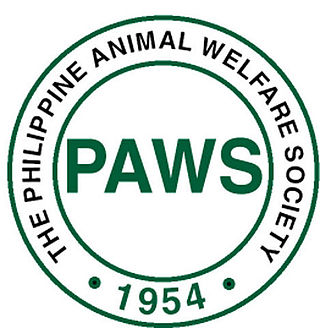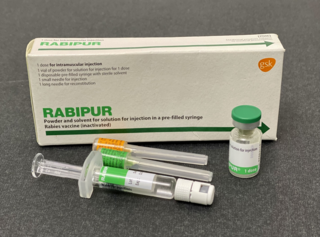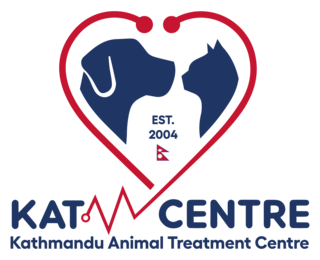Related Research Articles

An animal shelter or pound is a place where stray, lost, abandoned or surrendered animals – mostly dogs and cats – are housed. The word "pound" has its origins in the animal pounds of agricultural communities, where stray livestock would be penned or impounded until they were claimed by their owners.

World Animal Protection, formerly The World Society for the Protection of Animals (WSPA), is an international non-profit animal welfare organization that has been in operation since 1981. The charity's mission is to create a better world for animals by protecting them.

Vaccination of dogs is the practice of animal vaccination applied to dogs. Programs in this field have contributed both to the health of dogs and to the public health. In countries where routine rabies vaccination of dogs is practiced, for example, rabies in humans is reduced to a very rare event.

The Philippine Animal Welfare Society (PAWS) is a volunteer-based, non-government organization whose goal is to prevent animal cruelty through education, animal sheltering and advocacy, based in Quezon City, Philippines. It was founded in 1954 by Muriel Jay. PAWS believes that the creation of a more peaceful society starts with the widening of mankind's circle of compassion which includes animals, thereby envisions a nation that respects animals, practices responsible pet ownership and protects wildlife. The volunteer-based organization rehabilitates these animals in the hope of finding them new homes and a second chance at a good life. PAWS does not take in pets of other people, but only victims of cruelty or neglect where the animal offenders are charged with violation of the Animal Welfare Act in court.

The rabies vaccine is a vaccine used to prevent rabies. There are several rabies vaccines available that are both safe and effective. Vaccinations must be administered prior to rabies virus exposure or within the latent period after exposure to prevent the disease. Transmission of rabies virus to humans typically occurs through a bite or scratch from an infectious animal, but exposure can occur through indirect contact with the saliva from an infectious individual.
The one-dog policy is a policy implemented in 2006, restricting residents of Beijing City to one dog per family. It also prohibits Beijing residents from raising large and ferocious dogs. Effective from May 2011 onwards, a similar policy was implemented in Shanghai: each household is only allowed to register one dog, but unlike in Beijing, in Shanghai there is no size restriction for the dog owned. For instance, in Xujiahui, Shanghai, the local café Husky Go! allows clients to interact with Siberian Huskies, a dog breed that surpasses 35 cm (14 in) in height. Nonetheless, certain dog breeds perceived as potentially dangerous by the Chinese authorities are forbidden in Shanghai, including the Bulldog, Bull Terrier, and Mastiff.

Rabies is a viral disease that causes encephalitis in humans and other mammals. It was historically referred to as hydrophobia due to the symptom of panic when presented with liquids to drink. Early symptoms can include fever and abnormal sensations at the site of exposure. These symptoms are followed by one or more of the following symptoms: nausea, vomiting, violent movements, uncontrolled excitement, fear of water, an inability to move parts of the body, confusion, and loss of consciousness. Once symptoms appear, the result is virtually always death. The time period between contracting the disease and the start of symptoms is usually one to three months but can vary from less than one week to more than one year. The time depends on the distance the virus must travel along peripheral nerves to reach the central nervous system.

Street dogs, commonly soi dogs in Thailand, are ownerless, free-ranging dogs. These dogs are sometimes rounded up and sold as meat in Vietnam and China. It is estimated that there are about 8.5 million dogs in Thailand, of which about 730,000 are abandoned by their owners. Bangkok alone is estimated to have from 100,000 to 300,000 street dogs. Few have been vaccinated against canine diseases.
The prevalence of rabies, a deadly viral disease affecting mammals, varies significantly across regions worldwide, posing a persistent public health problem.
Karumkulam is a village in Thiruvananthapuram district in the state of Kerala, India.
Dogs, known in Classical Chinese as quan, played an important role in ancient Chinese society.

Street dogs, known in scientific literature as free-ranging urban dogs, are unconfined dogs that live in cities. They live virtually everywhere cities exist and the local human population allows, especially in the developing world. Street dogs may be stray dogs, pets that have strayed from or are abandoned by their owners, or maybe feral animals that have never been owned. Street dogs may be stray purebreds, true mixed-breed dogs, or unbred landraces such as the Indian pariah dog. Street dog overpopulation can cause problems for the societies in which they live, so campaigns to spay and neuter them are sometimes implemented. They tend to differ from rural free-ranging dogs in their skill sets, socialization, and ecological effects.

A free-ranging dog is a dog that is not confined to a yard or house. Free-ranging dogs include street dogs, village dogs, stray dogs, feral dogs, etc., and may be owned or unowned. The global dog population is estimated to be 900 million, of which around 20% are regarded as owned pets and therefore restrained.

The KAT Centre Nepal is a nonprofit organization in Nepal. The KAT Centre Nepal’s goals are to create a healthy, sustainable street dog population, reduce animal cruelty, and eliminate rabies, around Kathmandu, Nepal.

Soi Dog Foundation is a nonprofit organisation dedicated to improving the welfare of stray dogs and cats across Asia. Its headquarters is in Phuket, Thailand, and it is a legally registered nonprofit organisation in Thailand, US, Canada, Australia, France, UK, Switzerland, and the Netherlands. Its primary goal is to care for homeless and abused dogs in Thailand.
Free-ranging dogs have become a public health issue in the state of Kerala in India. Two persons died from dog attacks in 2016, and many persons were injured. Efforts to control the population have created conflicts between Indian advocates of public safety and opponents of animal cruelty, and caused international backlash including calls for a boycott of tourism to Kerala.

The Sarawak rabies outbreak is an ongoing rabies outbreak in the state of Sarawak in Malaysia. Until 6 December 2022, 49 confirmed rabies cases and 44 deaths have been reported.

Animal vaccination is the immunisation of a domestic, livestock or wild animal. The practice is connected to veterinary medicine. The first animal vaccine invented was for chicken cholera in 1879 by Louis Pasteur. The production of such vaccines encounter issues in relation to the economic difficulties of individuals, the government and companies. Regulation of animal vaccinations is less compared to the regulations of human vaccinations. Vaccines are categorised into conventional and next generation vaccines. Animal vaccines have been found to be the most cost effective and sustainable methods of controlling infectious veterinary diseases. In 2017, the veterinary vaccine industry was valued at US$7 billion and it is predicted to reach US$9 billion in 2024.

Animal welfare and rights in Goa refers to campaigns undertaken in the region of Goa, on the west coast of India, which has been on the rise in recent years. Goa is a popular tourist destination, visited by those from abroad and the rest of India, and concerns over animal rights has been built up both by local and visitor campaigns over the same.

The Tang Dog (唐狗) is an ancient medium-sized dog breed indigenous to southern China. Tang dogs are prized as a companion and watch dog but are also occasionally used for hunting and as meat dogs. The breed is named for the Tang Dynasty, a period of prosperity in China.
References
- 1 2 China press. "China press Archived 2009-06-03 at archive.today ." 无异于“血腥屠杀”陕西洋县屠狗万余成“无犬县”. Retrieved on 2009-05-31.
- ↑ Roberts, Joel (August 1, 2006). "China Slaughters 50,000 Dogs: Outrage Over 5-Day Massacre Of Dogs In SW China Anti-Rabies Crackdown". CBS News. Retrieved 2009-06-03.
- 1 2 "Killing of Chinese dogs prompts anguish, relief: Tens of thousands of canines killed to combat rabies outbreak". NBC News. Associated Press. 2008-08-07. Archived from the original on January 19, 2015. Retrieved 2009-06-03.
- ↑ Watts, Jonathan (2006-08-04). "China rabies outbreak triggers second dog cull". Guardian News and Media Limited. Retrieved 2009-06-03.
- 1 2 Stafford, Kevin (2007). The Welfare of Dogs. Springer-Verlag New York, LLC. ISBN 978-1-4020-6144-8.
- 1 2 Kureishi, A.; L.Z. Xu; H. Wu; H.G. Stiver (1992). "Rabies in China: recommendations for control". Bulletin of the World Health Organization. 70 (4). World Health Organization: 443–450. PMC 2393387 . PMID 1394776.
- 1 2 3 4 5 Shu-Xian, Zu (2001). "Epidemiology of rabies and control of dog rabies in China". Rabies Control in Asia: Fourth International Symposium on Rabies Control in Asia. World Health Organization. pp. 88–90.
- 1 2 Sina.com.tw "Sina.com.tw Archived 2009-06-03 at archive.today ." 陝西洋縣全城屠狗成全國首個無犬縣. Retrieved on 2009-05-31.
- ↑ Huanbohai news. "Huanbohai news. Archived 2009-06-18 at the Wayback Machine ." 陝西洋縣全城屠狗成全國首個無犬縣. Retrieved on 2009-06-03.
- 1 2 3 4 Juan, Shan (June 2, 2009). "Thousands of dogs killed to take bite out of rabies". ChinaDaily. Retrieved 2009-06-03.